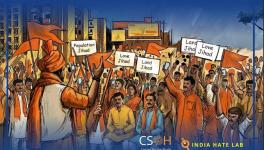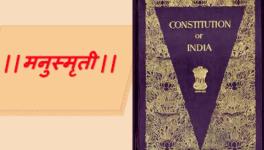UP Polls: Divisive BJP Agenda vs Public Angry after Covid, Eco Crisis
Representational Image.
The quest to conquer Uttar Pradesh in the Assembly election next year has intensified. The picture emerging in the state is of a triangular struggle between the ruling Bharatiya Janata Party versus the Samajwadi Party and Bahujan Samaj Party. The BJP and the entire Sangh Parivar have entered the fray in full force, equipped with every weapon in their Hintudva armoury. Chief Minister Adityanath is travelling across the state, making various announcements and attending inaugurations. Advertisements narrating his government’s claims and achievements—which include some of the ‘news’ about the BJP broadcast on TV channels or printed in the newspapers—are visible all over the state. Soon, TV channels will release pre-election surveys, although people have a more than fair idea of what they will say.
The SP and BSP have also reappeared after going silent for about a year and a half. They, too, are busy organising conventions and forums. But in the name of social engineering, they have turned to caste as their saviour. These parties either are unable to capture the grievances and anger at the grassroots, deliberately ignore them, or have failed to invent a narrative that could put them in the driver’s seat in the electorally crucial state. Therefore, the heavy loss of life and property due to the Covid-19 pandemic, back-breaking inflation and the livelihood and agricultural crisis is missing from election debates.
The Congress party has been active for the last two years and has established an organisational structure in the state, but it no longer has a solid social base to call its own. On Monday, Congress leader Rahul Gandhi drove to Parliament on a tractor in solidarity with the protesting farmers. No doubt, his party is trying to make its presence felt in Uttar Pradesh, where the three new farm laws have created a political vacuum. According to the 2011 Census, nearly 78% of Uttar Pradesh lives in its rural areas. Farming supports at least half its population of around 21 crores.
The ultimate goal of the Opposition is to become the principal force in the 2024 general election, for which it needs to score a victory in the Uttar Pradesh polls. With 80 Members of Parliament, this state holds the key to a government at the Centre. The BJP has this dream, too, and also challenges in its way. For one, the Suheldev Bharatiya Samaj Party (SBSP) led by Om Prakash Rajbhar has teamed up with the All-India Majlis-e-Ittehadul Muslimeen (AIMIM) led by Asaduddin Owaisi and announced a “Sankalp Morcha”. Rajbhar and Muslim voters are present in decisive numbers in multiple Uttar Pradesh districts including Bahraich, Ghazipur, Ballia, Varanasi, Mau and Azamgarh. How successful this new front will be—which could also mean how many anti-BJP votes they cut into—is hard to guess right now.
What it certain is the mass unemployment and skyrocketing inflation after the Covid-19 epidemic and lockdowns. The suffering of the people has increased tremendously. There is a deep sense of resentment towards the government. It is this anger that the politics of communalism and polarisation has tried to channel in recent months. Developments in the state over the last four-and-a-half years have laid the groundwork to polarise voters. It is now up to the Opposition to counter this narrative if they wish to succeed.
Especially during the first wave of the anti-NRC movement and then the Covid-19 pandemic and lockdown, the rhetoric of the ruling party leaders and the toxic news served by the embedded media deeply hurt the social fabric of the state. People never forgot the role of the police and administration during these episodes. “Love jihad,” NRC and the population rhetoric aside, the BJP sometimes banks on ‘local’ issues to drum up communal sentiment. Take the case of the Mohammad Ali Jauhar University near Rampur city and SP leader Azam Khan, or the raids on the homes of anti-NRC protesters. Arrests of the youth in the name of belonging to the “PFI” and many more such cases have kept cropping up in the BJP narrative over the last few years.
Mostly, Akhilesh Yadav of the SP and Mayawati of the BSP were quiet on these issues. Priyanka Gandhi did visit the state often, from Sonbhadra to Lucknow and Bijnor to Hathras. However, whether the efforts prove worthwhile or get dismissed as sporadic interest remains to be seen. Fact is, Akhilesh and Mayawati seem to have assumed that they will leap over the electoral hurdle by setting up the caste equation in their favour. Secondly, they hope to benefit from the anger of the public against the current government! Of course, this is one strategy the Congress party has been guilty of adopting, too.
Before the last election in 2017, the atmosphere in Kairana in western Uttar Pradesh had become heated due to BJP leaders who claimed there was an exodus of Hindus from the region and large-scale conversions to boot. Then a prominent leader had compared cremation grounds with cemeteries and distinguished “electricity” for Diwali from that for Ramadan and so on. In the end, in the absence of a counter-narrative, the BJP gained from the polarisation it fanned and the caste mathematics it firmed up.
During the last election, the SP-Congress alliance had attempted social engineering too. Akhilesh and Rahul Gandhi had offered joint prayers at the prominent Kashi Vishwanath temple in Varanasi, but their parties did not gain from it. To be fair, Akhilesh had spoken the language of development, too, and he had challenged the BJP’s ‘sabka saath…’ slogan. That was in 2011 when he was being painted as pro-minority, even communal, by the BJP, for example, because his government had announced a laptop distribution scheme for minority students. That said, in the end, the BJP bluster had proved too hard for voters to resist.
Now, even before this election campaign truly gets going, the BJP seems to be raising similar divisive issues and the opposition parties need to watch out. A few weeks ago in Ghaziabad, some miscreants chopped off the beard of an elderly Muslim man. It is still not clear what transpired in this case, but the police have denied it was a communal incident and sought to register FIRs against the journalists who said it was. Then came the issue of a hand pump in Saharanpur. Even this was made into a Hindu-versus-Muslim dispute. Members of a right-wing organisation created a ruckus and raised slogans at the site of the dispute.
Even “love jihad” and the Rohingya refugee crisis have cropped right up at the beginning of the Uttar Pradesh campaign, followed by the draft population policy in the state. TV channels are hosting vigorous debates over the religious conversion and population growth. Unfortunately, this is likely to continue till the end of the election.
The important thing is that this time such issues are not sailing with the public. The main reason is that the Covid-19 epidemic has left businesses and incomes devastated. The livelihood crisis has intensified due to high inflation. Especially the lower middle class and the poor are suffering as never before. The strategists of the BJP-RSS are only too aware of this. They know if they lose this election, their party will travel down a very different road than since 2014. This is why the BJP’s election campaign is becoming increasingly aggressive and polarising. More such arrows may have to be pulled from the BJP’s quiver in coming days. It is why observers of the developments in Uttar Pradesh are saying that even though the Opposition seems weak in terms of resources and strength if it competes vigorously, voters have decided to defeat a party that has let them down. All a large section of the public wants to see is these parties and leaders stand by them, fighting over the issues that matter.
(The author is a freelance journalist. The views are personal.)
Get the latest reports & analysis with people's perspective on Protests, movements & deep analytical videos, discussions of the current affairs in your Telegram app. Subscribe to NewsClick's Telegram channel & get Real-Time updates on stories, as they get published on our website.
























